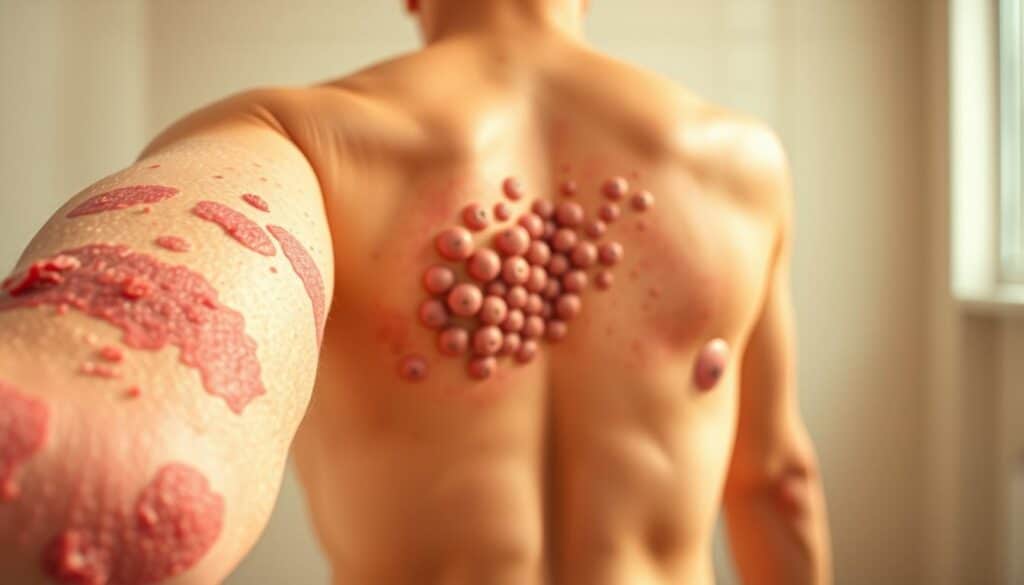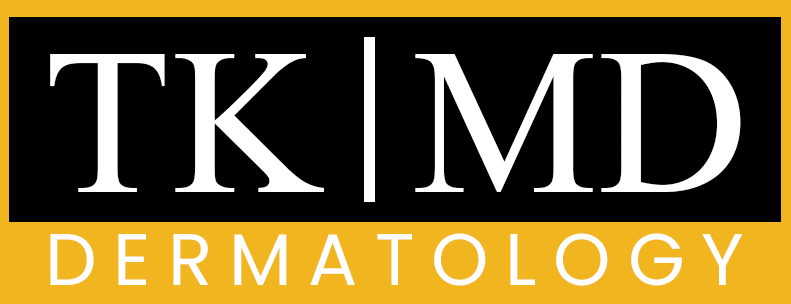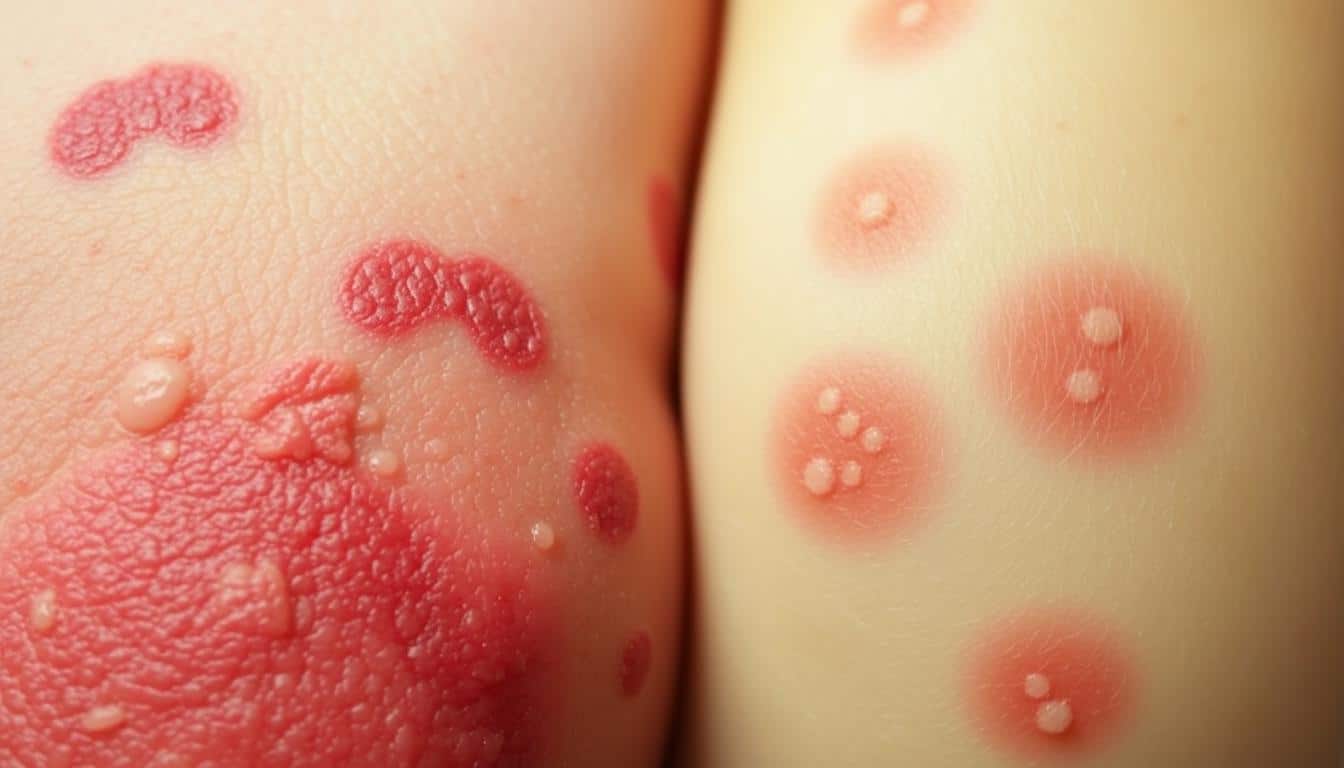Dealing with unpredictable skin conditions can feel like trying to find your way through a maze. Our skin tells us about our health, how vulnerable we are, and how strong we can be. This is true when we face tough disorders like eczema and shingles.
These conditions can really change our daily lives. They cause both physical and emotional pain for millions of Americans.
In the United States, many people deal with skin disorders like eczema and shingles. About one in three people will get shingles. Also, around 10.1% of people will have some form of eczema. It’s important to know the differences between these skin rashes to get the right treatment.
This guide will help you understand the world of these skin disorders. We’ll look at the unique signs, symptoms, and how they can affect your health. This will give you the knowledge to handle these tough conditions better.
Key Takeaways
- Eczema and shingles are distinct skin disorders with unique symptoms
- About 30 million people in the US are affected by eczema
- Shingles risk increases significantly after age 60
- Both conditions can cause significant discomfort and emotional stress
- Proper diagnosis is essential for effective treatment
Understanding Skin Conditions: An Overview
Skin disorders are complex conditions that affect health and life quality. Our skin protects us, and when it’s disrupted, problems arise. This can have big effects on our lives.
Common Characteristics of Skin Disorders
Skin irritations have common traits that doctors look for. These include:
- Visible changes in skin texture and appearance
- Persistent or recurring symptoms
- Potential for inflammation and discomfort
- Varying levels of severity
Impact on Quality of Life
Dermatological conditions can deeply affect our emotional and physical health. Studies show that 15-20% of kids and 1-3% of adults have chronic skin issues like eczema. This can cause:
- Reduced self-confidence
- Social anxiety
- Disrupted sleep patterns
- Potential psychological stress
Importance of Accurate Diagnosis
Getting the right diagnosis is key for treatment. With more people dealing with inflammatory skin issues, knowing the differences is vital.
“Early and accurate diagnosis can significantly improve patient outcomes and quality of life.” – Dermatology Research Institute
| Skin Condition Prevalence | Percentage Affected |
|---|---|
| Eczema in Children | 15-20% |
| Eczema in Adults | 1-3% |
| Potential Shingles Development | 1 in 3 Adults |
Knowing these details helps both patients and doctors create better plans for managing skin conditions.
What is Shingles (Herpes Zoster)?
Shingles, also known as herpes zoster, is a viral infection. It happens when the varicella-zoster virus (VZV) wakes up again. This virus stays hidden in our bodies after we get chickenpox. It can come back years or even decades later.
This condition is complex and can really affect people’s health.
The viral infections like herpes zoster show up in certain ways:
- It appears as a painful, blistering rash
- It usually shows up on one side of the body
- It often hits the chest, abdomen, and face
Here are some important facts about herpes zoster:
| Age Group | Incidence Rate | Risk Characteristics |
|---|---|---|
| Under 40 | 1.2-3.4 per 1,000 persons | Low risk of complications |
| Over 50 | 3.9-11.8 per 1,000 persons | Higher risk of postherpetic neuralgia |
“About 1 in 4 people will get shingles at some point in their lives.”
It’s important to know how herpes zoster progresses. The first phase, or acute phase, lasts 2-4 weeks. This is when people are most contagious. Those with weak immune systems are more likely to get it. So, catching it early and treating it quickly is key.
What is Eczema (Atopic Dermatitis)?
Eczema is a group of inflammatory conditions that affect the skin. Atopic dermatitis is the most common type. It impacts millions worldwide, causing discomfort and daily challenges.
Atopic dermatitis is a complex skin condition. It causes persistent inflammation and intense itching. Unlike temporary irritations, it can greatly affect one’s quality of life.
Types of Eczema
The main types of eczema are:
- Atopic dermatitis (most common)
- Contact dermatitis
- Dyshidrotic eczema
- Nummular eczema
- Seborrheic dermatitis
Common Affected Areas
Atopic dermatitis often appears in certain areas:
| Age Group | Common Affected Areas |
|---|---|
| Infants | Face, cheeks, scalp |
| Children | Elbows, knees, hands |
| Adults | Neck, upper chest, hands |
Chronic Nature of the Condition
Atopic dermatitis is a long-term inflammatory condition. Research shows about 50% of children might outgrow it. But others may continue to have symptoms into adulthood.
“Understanding your skin’s specific triggers can help manage atopic dermatitis more effectively.”
The condition is widespread, affecting 10-20% of children and 2-3% of adults globally. Genetic predisposition is key, with higher risks for those with family histories of allergies.
Eczema vs Shingles: Key Differences

It’s important to know the differences between eczema and shingles to get the right treatment. Both affect the skin, but they start in different ways and show different symptoms.
Here are the main differences:
- Cause: Shingles comes from the varicella-zoster virus, while eczema is an inflammatory skin condition
- Transmission: Shingles is contagious; eczema is not spreadable
- Pain characteristics: Shingles causes intense nerve pain, whereas eczema mainly causes itching
The rashes look very different too. Shingles shows up as a stripe on one side of the body, mostly in people over 50. Eczema can cause rashes all over the body.
“One in three adults who have had chickenpox can develop shingles, highlighting the complexity of viral skin conditions.”
How long they last and if they come back also varies. Shingles usually goes away in 3 to 5 weeks and only happens once. Eczema, being a long-term condition, keeps coming back and can be managed but not cured.
Knowing these differences helps people spot the signs and get the right treatment for these skin issues.
Causes and Risk Factors of Shingles
Shingles is a viral infection caused by the herpes zoster virus. It happens when the varicella-zoster virus, which causes chickenpox, wakes up in the body. Knowing what causes and increases the risk of shingles can help protect against it.
Viral Reactivation Process
The varicella-zoster virus hides in nerve tissues after chickenpox. When our immune system weakens, the virus can wake up and cause shingles. About 1 in 3 people who had chickenpox will get shingles at some point.
Age-Related Risk Factors
Age is a big factor in who gets shingles. Here are some important facts:
- People over 50 are at higher risk
- The risk goes up with each decade of life
- Those 60 and older face more severe complications
Immune System Connection
Many things can weaken our immune system and lead to viral infections like herpes zoster:
| Immune System Weakening Factors | Potential Impact |
|---|---|
| Long-term medication | Doubles shingles risk |
| Chronic diseases | Increases viral reactivation probability |
| Emotional stress | Suppresses immune function |
Getting the Shingrix vaccine can lower shingles risk by over 90% for those 50 and older. Starting treatment within 72 hours of the rash can also help avoid serious problems.
Understanding Eczema Triggers and Risk Factors
Eczema is a complex inflammatory condition affecting millions globally. It has many triggers and risk factors.
Genetics play a big role in eczema. Kids are two to three times more likely to get it if a parent has it.
“Eczema is not just a skin problem—it’s a complex interplay of genetic, environmental, and personal health factors.”
Primary Triggers of Eczema
- Environmental Allergens
- Dust mites
- Pet dander
- Pollen
- Mold spores
- Household Irritants
- Soaps
- Detergents
- Cleaning products
- Personal Factors
- Stress
- Hormonal changes
- Lack of sleep
About 10-20% of kids and 1-3% of adults worldwide have eczema. It can really affect their lives, with almost 50% saying it limits their daily activities.
| Trigger Category | Prevalence | Impact Level |
|---|---|---|
| Environmental Allergens | 60% of patients | High |
| Psychological Stress | 30% of patients | Moderate |
| Genetic Factors | 50% of cases | Very High |
Knowing these triggers helps people manage their eczema better. It can lessen the pain from skin irritations.
Recognizing Symptoms and Patterns
Understanding skin rashes can be tough. Knowing the signs of conditions like eczema vs shingles is key for right treatment.
Visual Identification Guide
Different skin conditions have unique signs. For shingles and eczema, these signs are very important:
- Shingles shows up as a localized, painful rash on one side of the body
- Eczema looks like widespread, itchy patches with skin color changes
- Shingles rash follows a specific strip or band pattern
- Eczema skin is often scaly and rough
Pain vs Itching Characteristics
The way these conditions feel is very different:
| Condition | Primary Sensation | Intensity |
|---|---|---|
| Shingles | Burning, Sharp Pain | High |
| Eczema | Intense Itching | Moderate to High |
Duration and Recurrence
Knowing how long these conditions last helps manage them better:
- Shingles usually lasts 2-4 weeks and rarely comes back
- Eczema is ongoing and can flare up often
- About 1 in 3 people will get shingles at some point
- Eczema affects 10-20% of kids and 1-3% of adults worldwide
“Recognizing the unique characteristics of skin rashes is the first step towards effective management and treatment.”
Treatment Options for Shingles
Shingles is a viral infection caused by herpes zoster. It needs quick and thorough treatment to ease symptoms and avoid complications. Our treatment plan includes several steps to help with pain, virus control, and symptom relief.

Antiviral drugs are key in treating herpes zoster. If taken within 72 hours of symptoms starting, they can lessen the infection’s severity and length.
Recommended Antiviral Medications
- Famciclovir
- Valtrex (valacyclovir)
- Zovirax (acyclovir)
Managing pain is also vital in shingles treatment. There are many ways to ease discomfort:
Pain Relief Strategies
- Over-the-counter NSAIDs
- Prescription pain medications
- Topical pain-relieving creams
Effective Home Remedies
- Oatmeal baths
- Calamine lotion
- Warm compresses
- Cool, wet dressings
Early treatment is essential to lessen shingles’ effects and prevent long-term issues.
For those at high risk, getting vaccinated is a good defense. The Shingrix vaccine cuts shingles risk by over 90%. The CDC suggests it for adults 50 and up.
| Vaccine Details | Recommendation |
|---|---|
| Shingrix Vaccine | Two shots, 2-6 months apart |
| Age Group | 50 years and older |
| Effectiveness | Over 90% protection |
While these treatments can help with shingles, it’s important to talk to a healthcare professional for advice tailored to you.
Managing Eczema Effectively
Living with atopic dermatitis means you need a full plan to handle skin irritations and inflammation. Our guide will show you the best ways to control eczema and keep your skin healthy.
Topical Treatments for Relief
There are several important topical treatments for managing eczema:
- Moisturizers with ceramides from brands like CeraVe® and Aveeno®
- Topical corticosteroids to reduce inflammation
- Calcineurin inhibitors for sensitive skin areas
- Prescription topical medications targeting specific symptoms
Lifestyle Modifications
Managing eczema goes beyond just medical treatments. Making some lifestyle changes can really help:
- Maintain a consistent skincare routine
- Avoid known trigger substances
- Manage stress through relaxation techniques
- Use gentle, fragrance-free products
Prevention Strategies
| Strategy | Description |
|---|---|
| Skin Hydration | Use moisturizers multiple times daily |
| Environmental Control | Use humidifiers, avoid extreme temperatures |
| Dietary Considerations | Identify and avoid food triggers |
“Over 31 million Americans manage eczema daily, proving you’re not alone in this journey.” – National Eczema Association
With over 31.6 million people in the United States dealing with atopic dermatitis, it’s key to know and use good management strategies. This helps keep your skin healthy and improves your life quality.
When to Seek Medical Attention
Dealing with skin issues like eczema and shingles can be tough. It’s key to know when to see a doctor. This helps manage the condition and avoid serious problems.
- Intense pain or persistent discomfort in affected skin areas
- Signs of infection, such as increased redness, warmth, or pus
- Rapid spreading of rash or blisters
- Fever accompanying skin symptoms
- Changes in skin texture or unusual color variations
“Early intervention can significantly reduce the risk of long-term complications in skin disorders.” – Dermatology Research Institute
For shingles, quick medical help can stop serious nerve damage. It also shortens symptoms. In eczema, seeing a doctor is vital when home treatments don’t work.
| Condition | Urgent Medical Consultation Signs |
|---|---|
| Shingles | Severe pain, spreading rash, compromised immune system |
| Eczema | Extensive inflammation, possible bacterial infection |
For expert dermatological care, contact TK Dermatology:
- Orlando Location
- Clermont Location
- The Villages Location
- Phone: (352) 565-7575
About 1 million shingles cases happen each year in the U.S. This shows why getting professional help for eczema vs shingles is so important.
Prevention and Long-term Management
Managing conditions like eczema and shingles needs a full plan. This plan covers prevention and long-term care. Knowing how these skin issues work helps people find ways to lessen symptoms and lower the chance of them coming back.
Prevention Strategies for Eczema
Eczema management aims to stop flare-ups. Important steps include:
- Identifying and avoiding personal trigger factors
- Maintaining consistent skincare routines
- Using appropriate moisturizers
- Managing stress levels
With over 31 million people in the U.S. affected, it’s key to understand how the immune system works. Patients with eczema often need special care to control skin inflammation and prevent problems.
Shingles Prevention Approach
Shingles prevention mainly depends on vaccination. Experts suggest:
- Getting vaccinated, mainly for those over 60
- Knowing your personal risk factors
- Keeping an eye on your immune system health
Almost 1 in 3 people will get zoster at some point, making prevention very important.
We focus on early action in managing skin disorders. This includes education, medical help, and care plans tailored to each person.
Living with Skin Conditions: Support and Resources
Dealing with skin disorders can be tough, but you’re not alone. Our community has many support systems and resources to help. It’s important to understand the emotional and physical effects of these challenges for full care.
Local Support Groups
Meeting others who face similar issues can really help. Local support groups let you share tips, learn about new treatments, and connect with others. They meet in places like community centers, hospitals, or online, making it easy to talk openly.
Educational Resources
Knowing a lot about your skin condition is key. Groups like the National Eczema Association and American Academy of Dermatology offer lots of info. They help you understand your condition, treatment options, and how to take care of yourself.
Professional Help Options
For the best care, see a dermatology clinic. TK Dermatology is a top choice, with plans made just for you. Call (555) 123-4567 or visit www.tkdermatology.com for help tailored to your needs.


